Following up on a preliminary survey of debunked COVID-19 related messages online, researchers Syeda Zainab Akbar, Divyanshu Kukreti, Somya Sagarika, and Joyojeet Pal sought to understand how the kinds of misinformation surrounding the pandemic have changed over the last few months. The researchers expanded their initial classification to encompass the broad themes that defined the various kinds of misinformation being spread. The following data is excerpted from the study by Syeda Zainab Akbar, Divyanshu Kukreti, Somya Sagarika, and Joyojeet Pal. The ‘we’ refers to the researchers: Two categories of misinformation have been rising consistently — stories around culture and the government. This is due to a visible increase in stories around Muslims and COVID-19 as well as stories around police brutality. In contrast, stories around casualty — or graphic imagery around COVID-19 infection or death as well as stories around cure peaked and started falling. As we see it, we are entering a phase in misinformation which is intended to be effective around identity and emotion rather than around instrumental facts that can be scientifically verified. Thus, from presenting fake cures or fake images of pain – which over time get debunked or appear suspicious to viewers, the misinformation has moved to cultural elements that are harder to verify. Categories of Misinformation Business and the Economy We classify messages under Business and Economy when messages relate to scams, panic-buying and target businesses with fake positive cases. [caption id=“attachment_8277801” align=“alignnone” width=“825”]  Wordcloud of all the tags associated with debunked misinformation stories related to business & the economy.[/caption] As we see above, the majority of misinformation here is intended to create some form of panic such as stories about essential commodities disappearing, fake shutdown notices of businesses and cash shortages. Casualty We classify a message under Casualty when they refer to fear-invoking messages related to deaths, suicides and suffering of people in the pandemic. These messages are distinct from death statistics in that they deal with the viscerality of the condition, such as descriptions of symptoms, visuals of death and suffering etc, intended to cause distress in the viewer. [caption id=“attachment_8277831” align=“alignnone” width=“825”] 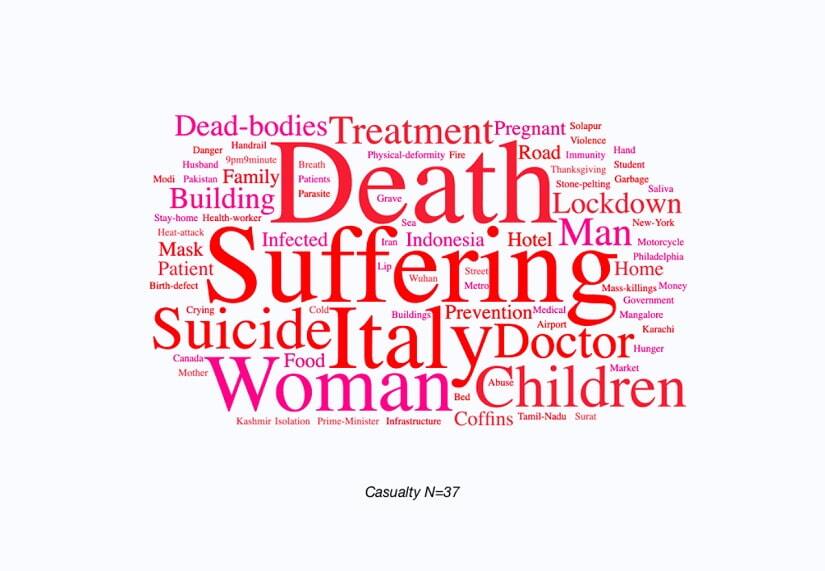 Wordcloud of all the tags associated with debunked misinformation stories related to COVID-related casualties (not death statistics).[/caption] A large share of the casualty-related messages were driven by the increase in casualties in Italy. As with other forms of content intended to incite fear, there are images/videos of dead-bodies, people suffering and of women and children in pain. Culture We classify messages under Culture when these are about a religious/ethnic/social group or have a popular culture reference. As the visualisation shows, culture-related misinformation has a very significant Muslim/Islam-related component. [caption id=“attachment_8277821” align=“alignnone” width=“825”] 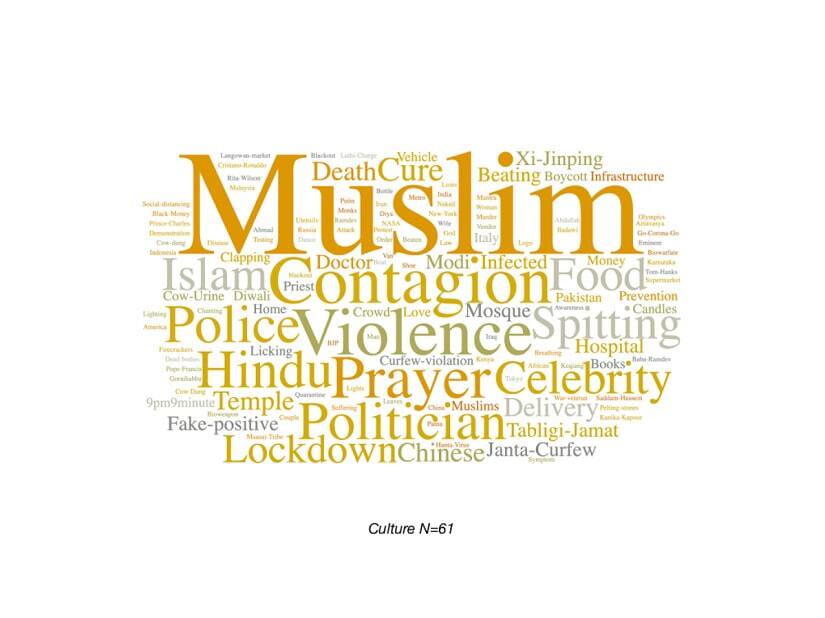 Wordcloud of all the tags associated with debunked COVID-related misinformation stories related to culture including ethnic groups, religion, popular culture etc.[/caption] While there was a significant China-related component in the earlier stories, as the coronavirus spread increased in India, religious references appeared in increasing numbers later. Muslims became an important part of the misinformation spread as spreaders of the coronavirus and provokers of chaos and violence, following the Nizamuddin Markaz incident. A frequently seen feature of culture-related misinformation is that they often rely on the use of a publicly recognised figure to grab attention of the reader. In one such case, Yoga master Baba Ramdev is presented to give credence to a misinformation claim that makes a cultural reference at Ayurvedic/Hindu practices. The rise in Culture related misinformation is not just attributable to negative messaging about Muslims. A large number of “positive” misinformation emerged both after the prime minister’s request to citizens to clap for health workers, and thereafter his next request to have citizens light up candles. Both led to misinformation about traditional scientific logic behind the move. The increase in culture-related misinformation also has related to ‘cure’ related tweets that lionise traditional knowledge such as Ayurveda, which also saw a brief spurt following the prime minister’s announcement. Cure, Prevention and Treatment We list under Cure, Prevention and Treatment messages suggesting remedies (alternative or mainstream), preventive measures, and vaccines-related misinformation. [caption id=“attachment_8277861” align=“alignnone” width=“825”] 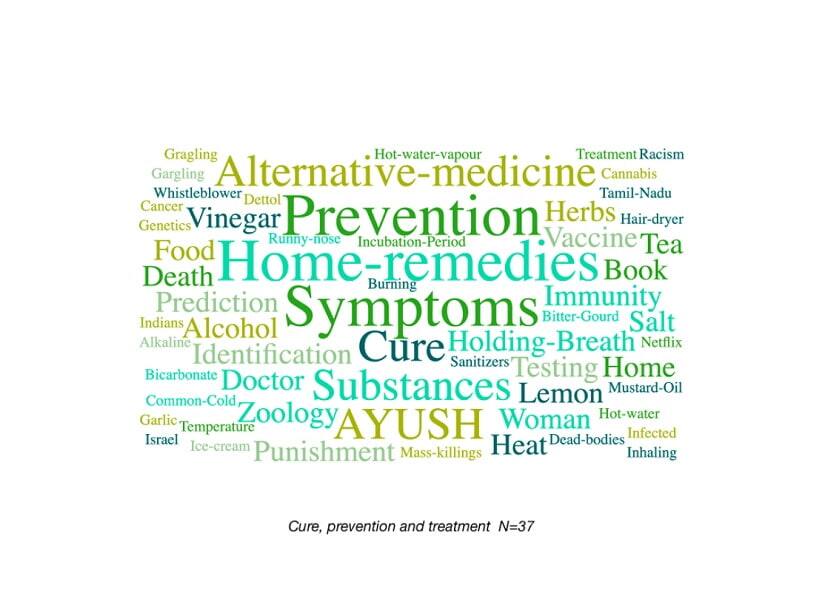 Wordcloud of all the tags associated with debunked COVID-related misinformation stories related to cure, treatment, and prevention.[/caption] We see two distinct trends – first is that of home remedies (including terms such as lemon, vinegar etc) and alternative medicines (Ayush, herbs etc). While cure-related misinformation was very significant early in the COVID spread, it gradually fell with the passage of time, since the remedies did not work, and they reached a saturation point, to use a COVID metaphor, there was herd immunity to some of the claims of alternative cures as it became increasingly clear from official sources that there was none. We find that cure-related misinformation has a higher share of institutional attribution to support its claims. An example from a debunked story shows St Luke’s Hospital of Kansas City was attributed with a claim that alcohol helps reducing the risk of COVID-19. An official-looking logo and letterhead are used to make the claim seem real.
Doctored statistics
Messages that have exaggerated numbers of positive cases or death counts and fake advisories. A look at the word cloud shows that institutions are often used to substantiate claims. Thus UNICEF, WHO or specifics about places where the statistics are from are cited to make them more believable. [caption id=“attachment_8277881” align=“alignnone” width=“825”] 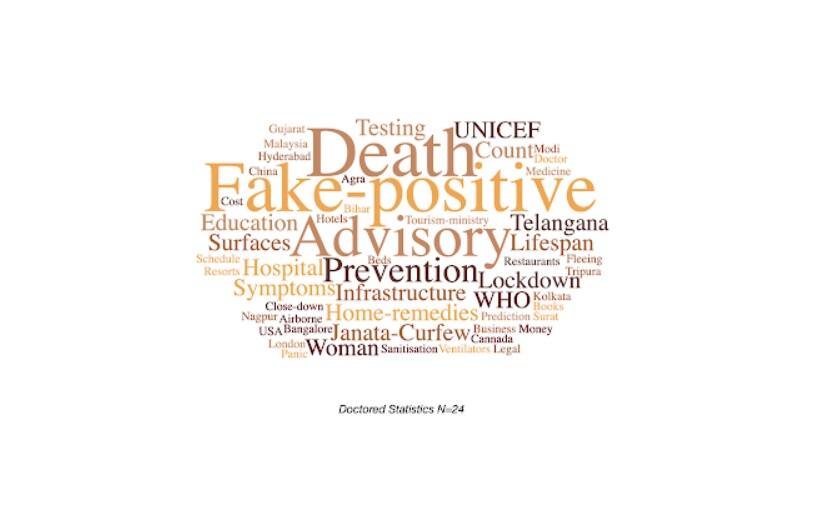 Wordcloud of all the tags associated with debunked COVID-related misinformation stories including statistics or advisories.[/caption] Institutions are often used to convince a reader of doctored statistics, in a case, the World Health Organisation is purported to have sent a message relating to India’s lockdown measures. Government We classify here messages have that purport to have government announcements and advisories and refer to police, judiciary and official institutions. [caption id=“attachment_8277891” align=“alignnone” width=“825”] 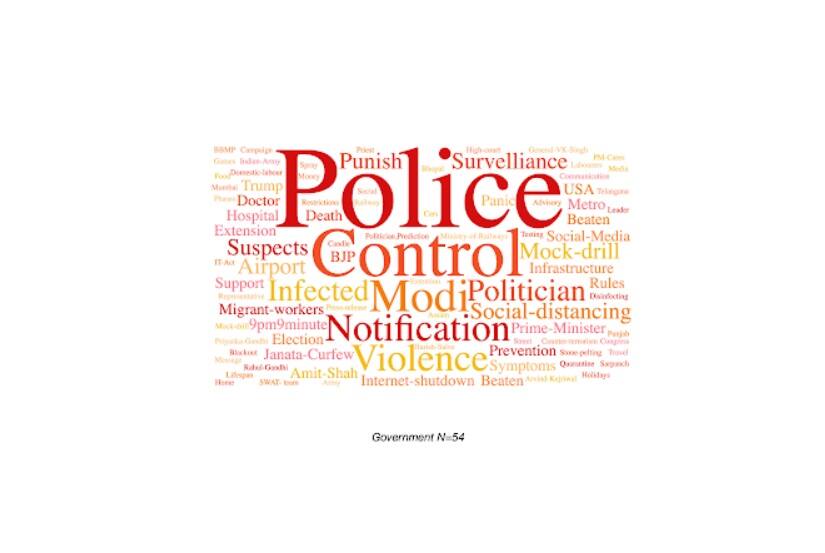 Wordcloud of all the tags associated with debunked COVID-related misinformation stories about the government, police and formal institutions.[/caption] As we see here, there is a significant component of tweets about the police, much of which is about police brutality, posts about which increased significantly after the lockdown began, and some legitimate news of police attacks on citizens started to surface In terms of legitimating claims of misinformation related to government agencies, governments or politicians, who can be projected as having inside information on the story, are frequently used, as in this story, where doctored visuals of an interface from a news source alongside a claim that Narendra Modi himself proposed an internet shutdown. Nature and the Environment Messages that have references to animals and the environment. There were two distinct strands around this heading. The first was around origins of the virus and nature-related potential causes, the second has been on the impact of the virus on nature. [caption id=“attachment_8277911” align=“alignnone” width=“825”] 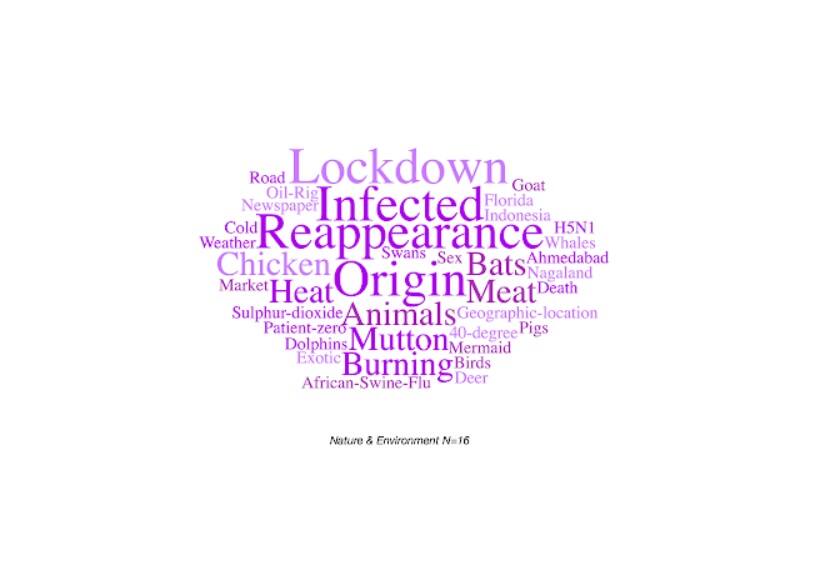 Wordcloud of all the tags associated with debunked COVID-related misinformation stories about nature and the environment.[/caption] One oddly popular thread of misinformation has been around “reappearance” – ranging from messages about animals roaming the street (again, there have been a small number of actual reported stories of animals out and about in various small towns and villages) such as herds of deer gathered on the Ooty-Coimbatore road to bizarre misinformation about mermaids appearing as a result of reduced human impact on the environment. Link to data. Read the full text here.


)

)
)
)
)
)
)
)
)



